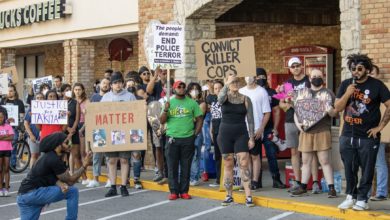For decades, it has been a familiar sight and sound in the urban neighborhoods of big cities across America—the chopping of police helicopter rotor blades circling overhead in a police manhunt of some sort. In the 1990s, hip-hop artists documented this regular interruption of privacy and quiet in their communities, calling the choppers “ghetto birds.”
Long before policies like stop-and-frisk became official doctrine or helicopters were widely in use, oppressed communities have lived under constant police surveillance in one form or another.
The helicopter is now facing some stiff competition from military drone technology that has been imported for the purposes of domestic law enforcement. The technology has rapidly advanced to search and survey from miles above ground.
Part of this is about cost. Explaining his desire to purchase domestic drones, Capt. Tom Madigan of the Sheriff’s Department of Alameda County, Calif., said, “In this time of austerity, we are always looking for sensible and cost-effective methods to improve public safety.”
The Federal Aviation Administration (FAA) has received approximately 80 requests for clearance to fly drones inside the United States, including from police and other government agencies. While information on the FAA requests was released via a Freedom of Information Act request filed by the Electronic Frontier Foundation, the extent of domestic drone use remains far from transparent.
Primed for rapid expansion
Last year’s funding bill for the Federal Aviation Administration included language requiring the agency to approve within 90 days local law enforcement agency requests to use small drones that weigh no more than 4.4 pounds and fly no higher than 400 feet. It also called for the FAA to adopt rules allowing for the “safe integration” of drones into U.S. airspace by Sept. 30, 2015.
The first green light for domestic drone use from the federal government came in 2005 when Congress authorized Customs and Border Protection to buy unarmed Predator drones to use for border security. It has since been revealed that these drones have also been used by a local police department in North Dakota. The department stated that two different military-sized Predator drones stationed at a nearby Air Force base had flown “at least two dozen surveillance flights” from June to December 2011. Some of these resulted in arrests of “cow thieves.”
In 2009, the Texas Department of Public Safety launched a bird-sized drone called a Wasp hundreds of feet into the sky and instantly beamed live video to law enforcement agents during a standoff with a wanted man who supposedly had a weapons cache in his house. They claimed that they feared the suspect might try to shoot down a helicopter.
“The nice thing is, it’s covert,” said Bill C. Nabors Jr., chief pilot with the Texas DPS. “You don’t hear it, and unless you know what you’re looking for, you can’t see it.”
Big-city police departments, including those in Los Angeles and New York, have officially held back on buying drones until the FAA guidelines for operating drones in congested airspace become clearer. But the domestic drone industry is expected to grow by leaps and bounds once this occurs. Recently, the LAPD reportedly used a drone to search for ex-cop Christopher Dorner in Southern California.
Unsurprisingly, the Supreme Court has provided little protection against the sort of covert police surveillance that is being mastered by drone engineers in the ever-expanding U.S. “security” industry. In the 1986 California v. Ciraolo decision, it ruled that warrantless aerial observation of a person’s backyard does not violate the Fourth Amendment guarding against unreasonable searches and seizures. In the 1983 United States v. Place decision, they ruled that the constitutionality of a search can be extended if a non-human being, such as a dog or machine, is doing it.
A vision of the future
The FAA estimates that the worldwide drone market could grow to $90 billion in the next decade. If current trends perst, around 70 percent of that growth could occur in the domestic U.S. market.
It is fitting that the first known arrests attributed to Predator drone assistance came from nothing more than catching “cow thieves” in North Dakota. Rather than great matters of “national security,” that is how drones will be used if they expand as planned—to protect private property and increase the web of state surveillance even for petty crimes.
As millions of people are driven further into poverty through austerity and the elimination of livable wages—on top of the unemployment endemic to capitalism—the system will use this impersonal technology to monitor and entrap the “criminal element” it itself creates. In that sense, drones are new technology, but nothing new—just the latest species of ghetto birds.





